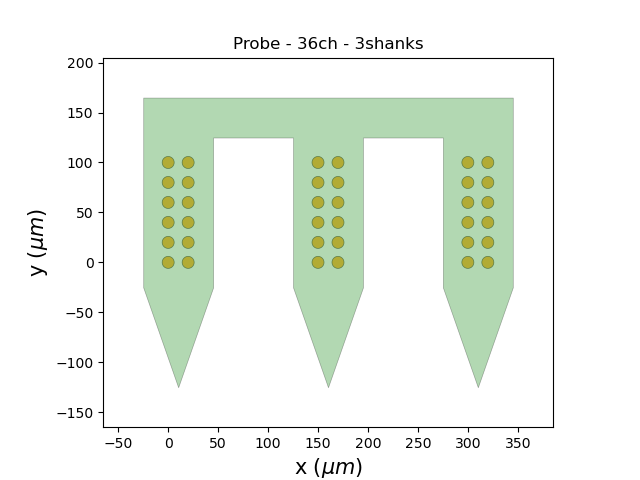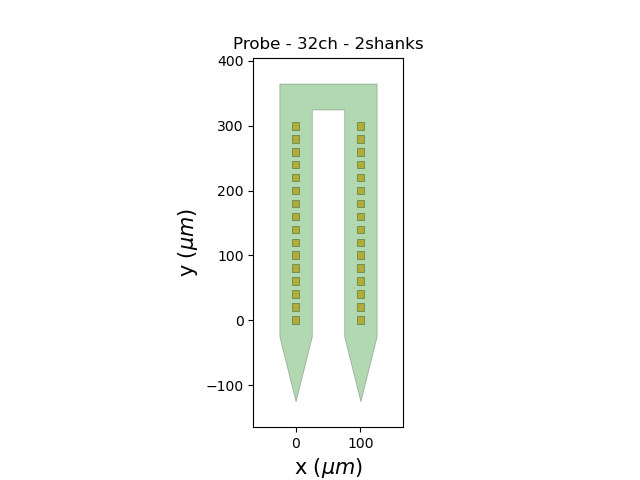Note
Go to the end to download the full example code
Multi shank probes¶
This example shows how to deal with multi-shank probes.
In probeinterface this can be done with a Probe object, but internally each probe handles a shank_ids vector to carry information about which contacts belong to which shanks.
Optionally, a Probe object can be rendered split into Shank.
Import
import numpy as np
import matplotlib.pyplot as plt
from probeinterface import Probe, ProbeGroup
from probeinterface import generate_linear_probe, generate_multi_shank
from probeinterface import combine_probes
from probeinterface.plotting import plot_probe
Let’s use a generator to create a multi-shank probe:
multi_shank = generate_multi_shank(num_shank=3, num_columns=2, num_contact_per_column=6)
plot_probe(multi_shank)

(<matplotlib.collections.PolyCollection object at 0x7f6b982d9e10>, <matplotlib.collections.PolyCollection object at 0x7f6b98237d90>)
multi_shank is one probe object, but internally the Probe.shank_ids vector handles the shank ids.
print(multi_shank.shank_ids)
['0' '0' '0' '0' '0' '0' '0' '0' '0' '0' '0' '0' '1' '1' '1' '1' '1' '1'
'1' '1' '1' '1' '1' '1' '2' '2' '2' '2' '2' '2' '2' '2' '2' '2' '2' '2']
The dataframe displays the shank_ids column:
df = multi_shank.to_dataframe()
df
We can iterate over a multi-shank probe and get Shank objects.
A Shank is linked to a Probe object and can also retrieve
positions, contact shapes, etc.:
for i, shank in enumerate(multi_shank.get_shanks()):
print('shank', i)
print(shank.__class__)
print(shank.get_contact_count())
print(shank.contact_positions.shape)
shank 0
<class 'probeinterface.shank.Shank'>
12
(12, 2)
shank 1
<class 'probeinterface.shank.Shank'>
12
(12, 2)
shank 2
<class 'probeinterface.shank.Shank'>
12
(12, 2)
Another option to create multi-shank probes is to create several Shank objects as separate probes and then combine them into a single Probe object
# generate a 2 shanks linear
probe0 = generate_linear_probe(num_elec=16, ypitch=20,
contact_shapes='square',
contact_shape_params={'width': 12})
probe1 = probe0.copy()
probe1.move([100, 0])
multi_shank = combine_probes([probe0, probe1])
print(multi_shank.shank_ids)
['0' '0' '0' '0' '0' '0' '0' '0' '0' '0' '0' '0' '0' '0' '0' '0' '1' '1'
'1' '1' '1' '1' '1' '1' '1' '1' '1' '1' '1' '1' '1' '1']
plot_probe(multi_shank)
plt.show()

Total running time of the script: (0 minutes 0.245 seconds)